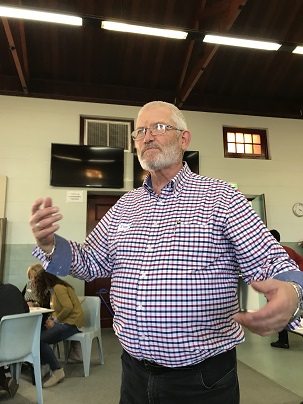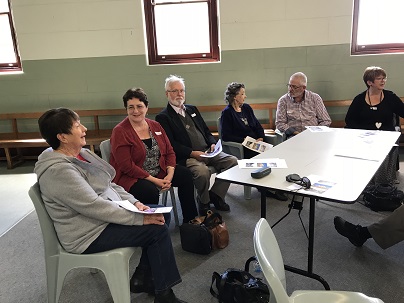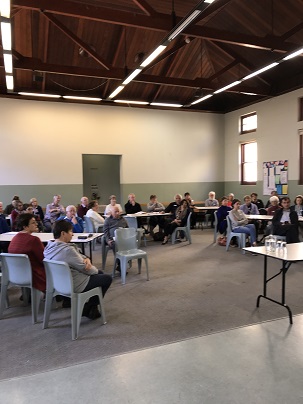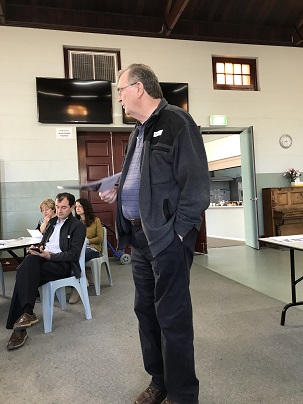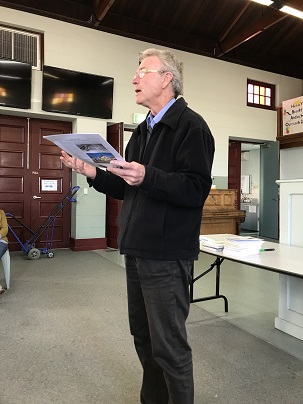Laity of the Chevalier Family
LAY MSC NEWSLETTER, MARCH 2018
FROM THE DIRECTOR
Greetings to all through this first newsletter for 2018. I pray that it will be a year of blessings for all of us.
Some of you would be aware that during the last ten years I have been producing booklets on aspects of the history of the Australian Missionaries of the Sacred Heat. I have focussed on biographies of some remarkable MSC as well as on special areas of ministry.
This year I plan to write a history of the Lay MSC in Australia. The movement began in 1971 through the ministry of Michael Fallon in Sydney and myself in Canberra. We had become aware of the original vision of our Founder to have a lay branch of our congregation which he called a Third Order. It had lapsed following his death in 1907.
In the 1970s Michael had several groups of young people in Sydney, mainly university students, while I had one group in Canberra consisting generally of parents of Daramalan students. Our Provincial Chapter of 1980 gave official endorsement to the movement. Gradually groups were formed in other cities where there was an MSC community.
While I have the assistance of much archival material, it would help me considerably to make a more interesting story if existing groups could provide me with some personal recollections of significant events and programs that occurred over the years. If that could be discussed and a report sent to me by May 31 I would be most grateful.
Meantime Fred Stubenraugh and the Lay and Professed MSC Council are attempting to extend the Lay MSC outreach. A report on this occurs elsewhere in this newsletter.
God’s blessings to you all.
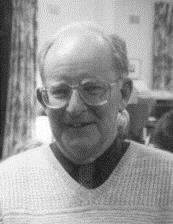
Jim Littleton MSC
SYMPOSIUM
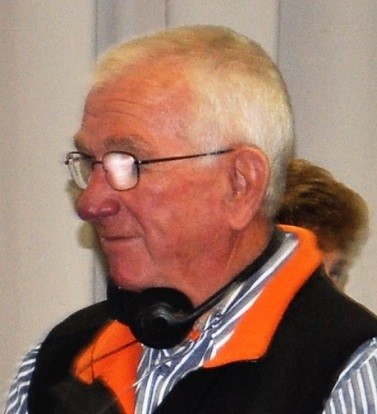
Fred Stubenrauch
At the General Assembly of the Laity of the Chevalier in Sao Paulo, Brazil in July 2017 the General Guiding Principles and Statutes of the Laity of the Chevalier Family were officially approved by those present.
They are a great step forward in the development of the worldwide organisation of the laity of the Chevalier Family.
There are certain implications for the organisation of groups of Lay people associated with OLSH and MSC in the various countries.
The members of the MSC Lay and Professed Council and the OLSH Leadership Team have begun discussing those implications and it has been proposed to hold a symposium of members of the Council and others to give thought to a way forward.
I must confess that it is my idea to hold such a meeting and I came up with the word symposium after which thought I should check its meaning!!
Doctor Google gave me the following: Symposium.
a conference or meeting to discuss a particular subject.
a drinking party or convivial discussion, especially as held in ancient Greece after a banquet (and notable as the title of a work by Plato).
Could I point out that the former is the idea I had in mind!!
The minutes of the symposium follow and also a letter from the International Council, some of the information in it is repeated in the minutes.
I would be grateful if you would send any comments on these articles or ideas for the agenda for future meetings.
Best wishes to all!
Fred
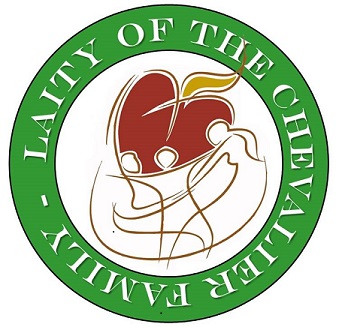
LAITY OF THE CHEVALIER FAMILY, MARCH 4th, ST MARY'S TOWERS
Present:
Fred Stubenrauch, Sue Stubenrauch, Paul Compton, Katherine Tonini, Aidan Johnson, Alison McKenzie, Phil Fitzgerald, Ancilla White, Therese Poulton, Ellenmary Lomman, Terie McNamara, Claudette Hiosan, Jenny Missen, Judith Carroll, Jan Clark,Christine Sivewright, Marian England, Irene Crittenden, Dain Inglis, Steve Dives, Maureen Maher, Gemma Farrugia.
Apologies: Sarah Beer, Alex Ying, Jim Littleton, Martha Johnson
The group met for Mass with the SMT parish followed by morning tea with parishioners. They then gathered at Heartworks at 10:30 am.
Record of the meeting
The gathering began with each person introducing themselves to the group.
Reflection: Ancilla presented a reflection titled, “New Wineskins”. Something new cannot be constrained by older structures and methods. It is time to look at things differently.
Jenny Missen generously agreed to prepare a record of the meeting.
- 1. Why are we here?
To help guide the Australian Province of MSC, OLSH, MSC Sisters and wider Chevalier family in a response to the “Guidelines” document approved by the General assembly of the Laity of the Chevalier Family, July 2018.
(“Guidelines” refers to the document “General Guiding Principles and Statutes of the Laity of the Chevalier Family”)
The MSC sisters had been contacted and while they were unable to be present, we include them in our considerations.
- 2. We next considered Jules Chevalier’s vision of professed and lay people involved in the mission of bringing God’s Love to the world.
We referred to the paper presented by Hans Kwakman MSC in Sao Paulo July 2017. Jules Chevalier was very insistent on the inclusion of the laity in the mission. The original vision of Fr Chevalier is outlined in the quote from Fr Ramiére, ‘In case the Vatican is not prepared to include secular priests or laity in these Constitutions, then the MSC Congregation will in no way differ from “one hundred and one” already existing congregations’
Fr Denis Murphy MSC was quoted as stating that at times the laity are even more essential than the professed. “Reading his early publications, about the nature and mission of his Society, I have the strong impression that (Fr. Chevalier) would have found it unthinkable, or perhaps even impractical, to speak of changing the world and its values without involving laity, for they were the ones more intimately immersed in that world. Religious priests, brothers, sisters, together with secular priests, had an essential role to play, and Father Chevalier stressed that. But if Christ’s mission was to be continued in the world on all levels of society, the role of the laity was at least equally as essential and at times even more essential
There was discussion highlighting the various aspects of Fr Kwakman’s talk, including the need for a change in the model from one in which the Professed are the centre to a way for Lay to be part of the formation of the “congregation” in a more formal way.
- 3. The International Council
Alison gave us an outline of her role as General Secretary of the International Council for the Lay Branch of the Chevalier family and their work to date.
The International Council currently consists of Alison, Rita Cleuren (Belgium) and Doris Machado (Brazil) accompanied by Fr Hans Kwakman. In the future the Council will be joined by people from each continent.
Rita, Doris and Alison are learning to work together via email. There have been trials with Skype and conference calls but this mode has so far been unsuccessful. So for now, email is the way to go and, of course there will be a need to meet face to face some time. This will take place in July in Issoudun with Fr Kwakman, and members of the Tri- Generalate.
The group invites all to contribute to the agenda for that meeting.
Currently, the trio is developing an accurate email database of those associated with the lay branch of the Chevalier Family.
The Imprimatur – international logo – will be located on any communication that comes from the International Council.
All documents need to be translated into German, Dutch, Portuguese, Spanish, English and French. This all takes a long time.
There is also a need to enact one of the key requests from Brazil – to find ways to become financially autonomous. Requests have been sent to countries to support the international and national councils
We need to articulate a family identity, what does lay spirituality look like? We know that Jules Chevalier’s vision is lived out in our lives both professed and lay. How can we be autonomous but still linked?
This articulation will also have to take into account cultural differences and also the tradition of MSC, OLSH, and MSC sisters as these are all different
- 4. Reading the Guidelines
Each person present spent time individually reading the Guidelines followed by opportunity to talk to a companion.
- 5. LUNCH - We had a wonderful lunch provided by the SMT kitchen staff and laid out for us by Heartworks (Gemma, Aidan and Kathryn)
- 6. Background of the Guidelines
After a gathering of Lay and Professed of the Chevalier Family in Santo Domingo in 2009 the European Committee was asked to develop the guidelines. After worldwide consultation comments were taken to the gathering in Brazil for consideration.
Some comments offered from the people present at the symposium:
We are MSC and OLSH if our life is committed to loving other people.
We need to reach out and let more people know about the charism.
We want to determine how to describe the culture in lay people terms.
The guidelines allow us to begin the process of moving us towards articulating what is at centre of our charism.
We want to catch the beauty of our charism to empower the laity to be confident and empowered to recognise, live and pass on/share the charism.
We need to work out a formula to cover all the viewpoints of all the groups.
Will the Lay and Professed Council and the OLSH Leadership Group still exist? Yes, because the National Council has a different role at this stage.
There was discussion around the sameness and differences of the groups. The conclusion is that there are many, many ways of implementing the mission, from individual to group. We have the same charism and we are all interested and need to be represented.
- 7. Where to from here?
We need to develop a National Council. How does that happen? It was decided that a steering committee would propose a model and membership.
It is envisaged that the National Council will be inaugurated sometime in 2019 at a date to be set by the steering committee
Alison proposed that we nominate members to form a steering committee with broad based representatives from OLSH and MSC and Heartworks with limited tenure of around a year to develop make up of the National Council.
We nominated:
Fred Stubenrauch as Chair
Paul Compton
Ellenmary Lomman
Marian England
Paul Stinson
Aidan Johnson
Jenny Missen
Therese Poulton
We also need to consider how we can be self-sufficient financially – a financial structure with $1000 to $1500 per year would be needed to support the International Council. Once formed, the National Council would also need to be financially self-sufficient.
It was decided that the steering committee will meet on Sunday 8th April at St Mary’s Towers.
Meeting closed 3:00 pm with the prayer God without Borders, a prayer said each day at the gathering in Brazil.
Update on the work of the International Council
Membership of the Council
Thus far, the International Council has three members: Alison McKenzie, Doris Machado dos Santos and Rita Cleuren. We are aware that the membership ultimately needs to be five people, one from each continent. The expansion of membership to include a representative from the Asian region or North America and possibly Africa will be discussed at our first face-to-face gathering. We are primarily communicating by email and, so far, that is satisfactory.
Issoudun Meeting
We have scheduled a face-to-face Council meeting in Issoudun from 12th – 16th July, 2018. The participants will be myself, Doris accompanied by her husband Ranulfo, Rita Cleuren, Paula as a translator, Fr Hans as the Accompanier of the laity and Sr Merle, as a representative of the Tri-generalate. We have begun the planning for the first Council meeting and welcome suggestions for the Agenda for that meeting.
Communication
We have refined the Data Base that the European Committee has used to communicate with the laity of the Chevalier Family over the years. We have a relatively accurate list of the key members and their accompanying religious. The next step is to try to get a contact person for each National Council. We intend to communicate regularly with the Laity through letters and newsletters.
We have translated the logo developed for the Brazil Gathering into all the languages and we intend to use that logo as a sign of authentic communication from the Council. We have also had the Guiding Principles translated into the languages of the family and we are very grateful to the translators for their on-going work. The final edited copy of the Guiding Principles with the logo has been sent out through the data base.
Progress towards self- funding
The Australian Province is in the process of opening an account for the lay movement that will be managed and audited by the Australian Province. The Trigeneralates have each contributed 1,000.00 Eu to that account and the European and Brazilian organising committees have transferred the residue of funds from the Brazil Conference into the fund. We intend sending a request to those countries who may be able to afford it to assist in building up the capital in that account. At this stage, the major cost is in bringing the Council members together, but my feeling is that face-to-face fellowship and meeting is essential if we are to progress in the implementation of the Guiding Principles.
Request for Information
We would like to have a report from each country on their progress towards the implementation of the Guiding Principles before the meeting of the International Council in July. We are not expecting that countries will have fully implemented the principles, but we would like to hear briefly how you are beginning the process.
Due Date: 23rd May to: This email address is being protected from spambots. You need JavaScript enabled to view it.
Could you comment on the following:
Name and contact for your National Council:
- Have you communicated or met together with groups of the Chevalier Family beyond your own group? Can you give some details.
- Have you begun to discern how you will form a National Council in your country? Can you give some details.
- Have you considered how you will appoint a chair of that Council who will have voting rights at the next General Assembly? Can you give details.
- Have you begun to consider how you will fund your National Council and the International Council? Can you give details.
- Can you attach a newsletter of general Communication that you have sent to the laity in your country?
Note: a brief comment is all that is required, but if you wish, you can comment more fully. Write in your own language and we will have your replies translated in time for our meeting in July.
SPIRITUALITY OF THE HEART - SOME DESCRIPTIONS.

“A Spirituality of the Heart is a way of being in the world. It is a journey to be travelled with others. It is an energy that sustains and moves us, a dance in which we are participating. It is a way of being in the world, in relationship to self, others and God: a way of coming to rest within ourselves, at our deepest centre” James Maher MSC
“Spirituality of the Heart is first and foremost something to be lived rather than understood. It demands that I first overcome divisions in my own thinking that create a sense of separation from self, from others, from God. This same separateness divides the body from the spirit, the human from the divine. It is no wonder we struggle to embody the mystery of God’s incarnation in Jesus, in our own lives and in actions”
Chris Chaplin MSC
“It is a missionary spirituality that is without limits - everywhere - at every level of society. Religious, diocesan priests and laity are called to share this spirituality. The laity are indispensable to carry our spirituality of the heart.”
Jules Chevalier
SPIRITUALITY OF THE HEART: spirituality for everyone
Fr Jules Chevalier MSC firmly believed that Devotion to the Sacred Heart was the solution to all the world’s problems. His invocation, “May the Sacred Heart of Jesus be everywhere loved – Forever” captures a key aspect of Chevalier’s spirituality and of his vision.
While each of the words in this invocation invite commentary I will focus on the word “everywhere”. It is clear that Chevalier understood “everywhere” in its geographical and social dimensions. So, not only would the devotion spread to every place on earth but it would also find a home into every strata of society from home to work place to religious communities, presbyteries etc – that is, this devotion was for everyone, everywhere.
In order to achieve this vision Chevalier understood that lay people as well as religious and clerics needed to be included in the society that he founded. Lay people then, are invited to discover ways to live this spirituality in their day to day lives and not simply in that aspect of their life that may be connected to the men and women religious who claim Chevalier as their founder. Just as religious men and women strive to find ways to express and live this spirituality in community so lay men and women need to strive to find ways to live and give expression to this spirituality in their life as single or married people in their homes, work places and beyond.
The key aspects of this spirituality will be similar for everyone. It begins with a journey to one’s own heart; in this we recognize the need we all have for quiet, still awareness, to be in touch with our inner self. In this inner journey we pay attention to the multitude of feelings and thoughts that are known only in solitude. In that place we intentionally open ourselves to the compassionate, loving heart of Jesus.
So spiritualty of the heart has this contemplative dimension. It also invites us to make the journey outwards from our own heart, to the hearts of others. And once again, in every person we meet, in whatever situation we find ourselves, we open ourselves to the abiding presence of the compassionate, loving heart of Jesus.
Spirituality of the heart invites us to make the inner journey to our own heart and the outer journey to the hearts of others in the belief that it is there that we encounter the compassionate, loving heart of Jesus. As we live this spirituality we become ever more sensitized to this compassionate, loving presence that manifests itself everywhere, in all dimensions of life. Living a spirituality of the heart gives witness and expression to this presence.
It is spirituality for everyone, everywhere.
P. Fitzgerald November 2015
Spirituality of the Heart – A Description
The quality that most describes an MSC is kindness. The MSC Constitutions describe and prescribe the MSC way: the Spirit of our society is one of love and kindness, humility and simplicity.
Jules Chevalier, Le Sacre Coeur
A Spirituality of the Heart is foundationally about love – not a soft sentimental love but a love which challenges and yet comforts … that is courageous and yet humble … that is hopeful and yet not blind to the problems of our world. It is a love that is strong and determined but does not crush the bruised reed … that is faithful and generous. Like Christ, it is compassionate, tender and merciful.
Fr Bob Irwin msc (2004)
‘To live,’ wrote Antoine de Saint-Exupery ‘ is to be slowly born.’ The fact is that coming to be fully alive is the task of a lifetime. There’s so much in each of us that we’ve never touched, so much beauty we’re steeped in that we’ve overlooked. Consciousness is what lifts the ordinary to the sublime.
The ordinary is what reveals to us little by little, inch by inch, the holiness of life – we wait for retreats, liturgies, grand gatherings to take us to God, and indeed they can and do; yet God is with us all the while – most especially in the routine parts of life, the dull parts of the day, which are the gifts of space – time for consciousness and reflection, time to continue being slowly born.
From: Joan Chittister osb – Listen with the Heart – Sacred Moments in Everyday Life (2003)
Let the beauty we love be what we do. There are a hundred ways to kneel and kiss the ground.
Rumi
Your beauty should be that of your inner self, the unfading beauty of a gentle and quiet spirit, which is of great worth in God’s sight.
1 Peter 3: 3 – 4
I used to think that holiness meant keeping the rules. Now I know that it means knowing the self. When I really know myself, I know what I must do to be the best I can become. Then, it becomes impossible for me to judge another. Holiness lies more in forgiving the other than in not sinning. (1)
It is one thing to forgive for the sake of civility. It is another to forgive from the heart. Civility urges us to maintain the connections we have for the sake of our own advantage. The heart urges us to go beyond the hurt to the place where freedom lies and learning happens and trust is possible again.(2)
From Joan Chittister osb (1) Becoming Fully Human – The Greatest Glory of God (2005) and (2) God’s Tender Mercy - Reflections on Forgiveness (2010)
The Church mystics of ancient times knew that we only become whole, and radically holy, when we learn to integrate our spiritual, transcendent self with our personal, human and fleshly self. Their exceptional and rounded balance of expression and description of centred holiness, their freedom in the use of sensuous images and physical feelings regarding union with God, all combine to delight us with a sense of embodied wisdom, love and power.
From: Daniel O’Leary Travelling Light – Your Journey to Wholeness (2001)
WEEKEND REFLECTION - LAY MSC - HENLEY BEACH MEETING

Thanks to Noel Mansfield for text and photos
Father Chevalier always wanted lay-people closely involved with his mission. I’ve always considered everyone in the parish as belonging to our charism and spirituality, so have been a bit ambivalent about starting an MSC Associates group within the parish. However, around 25 years we began a group at Henley Beach, and this eventually became 2 groups, covering people from both parishes and outside. The main aim of the groups was to study the life and spirituality of our Founder and deepen their own living of ‘spirituality of the heart’.
Recently, we became aware that we wanted more than just discussion groups or review of life – we needed to have some real impact on our parish. We have begun to host certain activities, such as days associated with the Feast of the Sacred Heart and the ‘feast’ of Jules Chevalier on October 21. We see ourselves more as of service to the parish and guardians of ‘spirituality of the heart’. We welcome new members, especially anyone interested in growing in our spirituality in their own lives and in the parish.
John Rate
The Charism of Jules Chevalie
Noel Mansfield, MSC
On Sunday, 22 October, there was a meeting of our parishioners who are interested in knowing more about the Charism of Jules Chevalier. There were more than 40 people who gathered at the Henley Beach hall.
Over the past few months, the parishes of Henley Beach and Hindmarsh-Findon have been advertising this event. Over the past couple of weeks, various Lay MSC have spoken at Weekend masses. The hope has been to awaken in the hearts of people a greater awareness of this charism.
John Wallace was the coordinator of the event on Sunday. He introduced each of the speakers. Between each of the talks, he encouraged us all to share what we had heard.
Rev. Robin Trebilcock, a Uniting Church minister, was the first speaker. Robin has been involved with the Lay MSC for many years and has visited Issoudun on a number of occasions. He also attended an MSC Provincial Chapter in Toowoomba. So he has a deep understanding of this charism.
Robin Trebilcock:
LAY MSC SPIRITUALITY - A Mission Focussed Spirituality - Notes
I want to suggest to you that Jules Chevalier’s Spirituality of the Sacred Heart is closely connected to his missionary focus and offer insight into the spirituality through an examination of his earliest mission - to the men of Issoudun. But first, let me open with a look at a discussion topic that you will be considering later:
“People are now more disengaged from, disinterested in, or hostile towards ‘church’.”
Bring to mind someone you know well who fits this description.
Name them (to yourself).
How many of their friends and work colleagues share these attitudes? A few? Some? Most?
How does he/she respond when you talk about your faith?
Would you risk your valued relationship by such a discussion or more likely to play it safe?
This is something I’ve wrestled with all my adult Christian life. It led me to the MSC’s and Heart Spirituality nearly 25 years ago and deeper into Jules Chevalier’s ministry ever since. He, like us, had to deal with a disengaged, disinterested and hostile public. The French Revolution unleashed a wave of popular, rationalist, humanist, anti-church attitudes that he called the mal moderne. These attitudes have grown and extended to become commonplace in the Western world today. His spirituality and missionary endeavour were both a response and an effective counter to them. His early ministry to men is a classic example. We know the results, which were outstanding, but not much else. My quote comes from Hans Kwakman, MSC. He wrote:
“Together with his confrères Maugenest and Piperon, Father Chevalier began to visit all the families in Issoudun to encourage the men to attend a special Mass only for them. After several weeks of home visits, which were often met with refusal, more or less polite, they've finally could count thirty meeting to attend a Mass for men only. These men persevered and their members even increased. During Lent of the year 1857, several hundred men gathered in the barn converted into a chapel to listen to conferences in preparation for Easter, and on Easter Sunday, fifty men received Holy Communion.”
How did he manage that? The terse report of the time glosses over the detail. Only by examining more recent programs and texts have I been able to piece together a probable scenario. The original plan, to focus on the men and to visit their homes and to have a special mass for them, became modified by the love and compassion that the men’s situation evoked in the visitors. The “Mass for Men” was still the end point, but a lot of listening, caring, healing and personal and social transformation happened on the way. So much so that the work’s reputation spread and people across France began making a pilgrimage to Issoudun to find similar wellness for themselves. The inscribed wall tiles in the Basilica are testimony to this.
The social history of the time, of revolution, terror, and the two Napoleonic war defeats, suggests that the distress among the men was akin to the post-traumatic stress that we recognised in returning Vietnam vets. The treatment evolved for the Vietnam veterans (and subsequently used for survivors of similar experiences), is like the attentiveness, compassion, peer support and practical assistance of the spirituality of the Sacred Heart that Jules Chevalier applied, with much success, to the men of Issoudun and subsequently to the pilgrims.
I believe that Chevalier’s visits and conversations also showed him that expecting the men to come to their special Mass at the church was too great a hurdle for them to overcome, so he acquired a barn and made it into a chapel. A barn is a familiar and non-threatening space for men in an agricultural town like Issoudun.
The inclusive, universal appeal of the MSC mission statement, ‘May the Sacred Heart of Jesus be everywhere loved’ was another help to the ministry. In a time of competing ideologies and factions, being loved and included by Jules Chevalier’s ministry no matter who you were or where you stood was in stark contrast to the mortal danger of such differences in the world at large. The image of Our Lady of the Sacred Heart that Jules Chevalier devised in Issoudun would have aided this ministry. Its portrayal, controversial at the time, of a mature Mary offering support, comfort and guidance to 12 year-old Jesus would have evoked memories of times on the battlefield or the barricades when, like 12 year-olds, the image of a comforting, guiding mother’s love supported them through their ordeal. It also made the connection - the heart of God, the heart of Jesus, the heart of their ministry, the Sacred Heart - more explicit.
Has Jules Chevalier’s example with the men of Issoudun any relevance today as a guide for us? Has it enduring worth beyond its time? My answer is, “Yes!” It was an effective response to a hostile environment. It healed and reconciled wounded lives and relationships. It would be just as effective responding to the anti-religious, anti-church attitudes and the social and personal distress of our time.
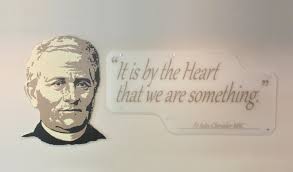
These are the aspects I believe should be reapplied for our time:
- Jules Chevalier’s Lay MSC activity happened in the mission field - the local community - not the church. The three priests visited all the families and grew the ministry by developing trust and a caring relationship with a few, who responded positively to the love and care that was offered, and to the Sacred Heart. They, in turn, had networks of love and care in the neighbourhood through which their new-found experiences could be shared. The group, the conversations, the healing and reconciliation and the relationship with the Sacred Heart grew. Their ‘cold-calling’ approach wouldn’t work today. Sacred Heart spirituality is and was developed and demonstrated in relationships built on conversation, healing and help formed in response to discerned individual and community distress. We need different ways now to initiate it.
- The men gathered in the barn, not the parish church. A barn was a familiar space for men in an agricultural town like Issoudun. We need to consider what are ‘familiar” and non-threatening spaces’ for our time.
- The image of Our Lady of the Sacred Heart helped put people in touch with experiences of love and hope that they knew and understood. And that provided a ground for accepting the ministry of the Sacred Heart that they were being offered. This image has probably lost much of its original potency. What might we use in a similar way?
- Applying the MSC mission statement, ‘May the Sacred Heart of Jesus be everywhere loved’ can take Lay MSC ministry into unexpected places and communities. Honouring its openness and acceptance requires a clear distinction between administering the Sacred Heart and recruiting people to church involvement. Church involvement may be a consequence of the love, trust, help and integrity of the Sacred Heart ministry, but it comes as a gift of the Sacred Heart to the church, not as a manipulation of the relationships involved.
- The special Mass for men was an important element in Chevalier’s approach to people disengaged from, disinterested in, or hostile towards ‘church’. Rationalists/humanists want to be able to explain everything, but, at its most profound level of experience, love cannot be explained - only experienced. Love is a mystery. Experiencing the eucharist is to experience the love of God and the Sacred Heart of Jesus as mystery. Nevertheless, the Mass needed to be ‘special’ - to come out of the experience of love they were receiving from the ministry team of priests and lay people.
Jules Chevalier’s Sacred Heart spirituality is a strong foundation for a Lay MSC ministry today. His pioneering work revealed a new way of being church, one that moved the emphases from head to heart, from exclusive to inclusive, from a distant, judgemental God to a loving, in our midst God who, in the Sacred Heart of Jesus, comes with healing and help in our distress. Lay MSCs are well placed to build from Chevalier’s foundation (with insights from more recent texts and ministries) to become a relevant and potent force for good and for God in our time.
----------
LAY MSC SPIRITUALITY - A Mission Focussed Spirituality - Questions
- People are now more disengaged from, disinterested in, or hostile towards “church”.
Bring to mind someone you know well who fits this description.
Name them (to yourself).
How many of their friends and work colleagues share these attitudes? A few? Some? Most?
How does he/she respond when you talk about your faith?
Would you risk your valued relationship by such a discussion or more likely to play it safe?
What does this say about how the church communicates what it stands for with the public?
What might work?
- Distress
Continue to consider the person you recalled in the first question.
What personal or social issues are causing them distress?
As you share in your group, do some issues loom larger?
- The love of God/the Sacred Heart of Jesus > our love.
Choose one distressing issue (or two).
How might the presence of love and compassion in the situation reduce the distress?
Do we have a role in making this presence felt? How?
How does heart spirituality bring the presence of the love and compassion of God and Jesus to bear on our personal experiences of distress?
-------------
Charism
After a short time for discussion, Paul Cashen gave us an insight into Richelieu, the town where Jules was born and then a picture of Issoudun - the small rural town where he developed his spirituality of the Heart and founded the Missionaries of the Sacred Heart.
Jules Chevalier
Born 15th March 1824 -- Died 21 October 1907
Jules Chevalier was born in the town of Richelieu in central France. The town of Richelieu takes its name from its founder, Cardinal Richelieu the hugely egotistical character who in his time, after the king, (Louis XIII) was the most powerful person in France.
The town is surrounded by walls and moats and people enter through the main gate that divides the town and leads up to what was the Chateau. The Cardinal decided his position demanded a great residence and in 1625 he commissioned the famous architect Jacques Lemercier to design his palace and then the town bearing his name. It was burnt to the ground during the French Revolution as a response by the people to the infamy of the Cardinal.
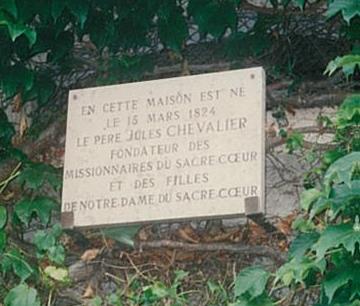
The main church "Eglise Notre Dame" remains in much the same condition as when it was first built, much like the timber framed market hall which is still used for the weekly market. This is where Jules was baptised on the 16th March 1824: there are various works of art that commemorate his life an d work. The church opens onto the Market Square and after walking through the market on the Rue des Halles the first street on the right, 1 Rue du Cygne is where Jules was born. His father was an educated man, but not very successful in either trade or business, and not a religious man at all. Jules' mother could neither read nor write, had never been to school, but was deeply religious. In this ambiguous atmosphere Jules grew up with competence in reading and writing from his father, and an awareness of God in his life from his mother. When he first let it be known that he wanted to be a priest, he was told immediately that this was quite impossible given the family's poor circumstances. He was needed to help support the family and was apprenticed to a shoemaker.
When Jules was seventeen years old, his father was given a job as "caretaker of forests" by a wealthy landowner near Vatan. Hearing that Jules was interested in becoming a priest, this man undertook to pay Jules' fees at the seminary. It was during his seminary days, that Jules Chevalier first dreamed of a group of people dedicated to the Heart of Jesus who would bring a message of love and hope to a world in which there was a complete indifference to God and an antagonism to any form of religion and a general feeling of hopelessness and despair.
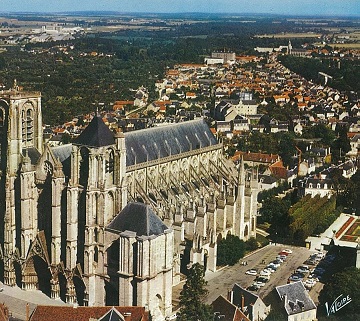
Jules was ordained in the Bourges Cathedral on the 14 June 1851. As a priest, Jules first served as curate in three different parishes in quick succession. Then at the age of thirty he was sent to Issoudun, which was regarded as the most dechristianised town in the whole region. The other curate in the parish was Fr Emile Maugenest, one of a small group of his companions in the seminary who had shared Chevalier's vision.
At Issoudun the two priests became determined to found a religious congregation of Missionaries of the Sacred Heart. However, aware that they could be deluding themselves they wanted a clear sign that this was what God wanted. Over a period of nine days, they prayed asking Our Lady to intercede for them in having God provide this sign. The following morning one of the parishioners called at the presbytery with a letter announcing a gift of 20,000 francs from an anonymous donor. The donor's preference was for a house of missionaries to be established in the area with the approval of the Archbishop. The Archbishop agreed as long as they had some means of financial independence and support. Another period of prayer resulted in another anonymous benefactor promising to give an annual gift of 1,000 francs which was enough for both of them to live on. They now had the sign and the means to begin the Missionaries of the Sacred Heart.
With the original 20,000 francs the two priests purchased a rundown vineyard with a sound house and tumbled-down barn in Issoudun. The house became their first community house and the barn was renovated as the first chapel, dedicated to the Sacred Heart of Jesus. This was in 1855. From these simple beginnings has come a whole family of Missionaries of the Sacred Heart - priests, brothers, sisters and lay associates.
The circumstances in France at the time were desperate for the ordinary person. They not only suffered in their family life and social interaction, they felt that religion was a thing of the past, and that the wars and revolutions meant that the world for them had changed. Jules set out to address this situation as he saw the Sacred Heart as the means of assisting the people to find God again. The humanity of Jesus and his relationship first to his Father and then with his mother Mary, held a special place for Jules. The statue of Our Lady of the Sacred Heart expressed for him this relationship, that if understood would help people find God again.
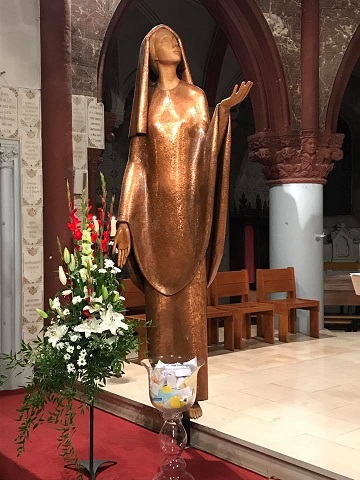
The French disillusion with God
After some difficult years of persecution in France and being forced to move to other parts of Europe, the new congregations began to grow and, at a very early stage, accepted responsibility for the Missions of Oceania.
It was as a direct result of this decision that the Missionaries of the Sacred Heart came to Australia at the end of the 19th century. Within twenty-five years of their small beginnings, the Missionaries of the Sacred Heart had spread in Europe and to North America. Before his death, Fr Jules Chevalier was to see his 'family' working in Central and South America, the Philippines, Australia and the Pacific Islands.
The sources of this paper were taken from notes and photos of Paul Cashen msc and texts from Jean Tostain msc “Father Chevalier”, the MSC website, from Wikipedia and map from Google.
Charism
Christopher Murphy, MSC:
Jules Chevalier from birth until his early years as an apostle to Issoudun.
For many years I used to regret that Jules Chevalier didn’t seem to do anything spectacularly holy in his early life. More lately I’ve heard and read that he regularly accompanied the local Parish Priest on his rounds after Mass each day (which he also attended). As a young lad of 11 or 12 this was a pretty heroic effort in a French winter I’d think.
When at 12 or so, he received his first Holy Communion, he surprisingly publicly stated (rare for him to reveal his deeper spiritual thoughts) that his 1st Holy Communion day was the happiest in his life, and furthermore, to the shock of his parents, he desired to become a priest.
Providence and a gift of money from a generous passer-by enabled Jules to start his Seminary days. The Seminary they recommended was just totally inappropriate for him, as it was a Minor Seminary and his fellow students at 13 or 14 were poor company.
Eventually it became clear that Jules needed to move on to the Seminary at Bourges Archdiocese, and here Jules performed admirably and with a number of fellow students he led and formed a small group of enthusiastic students into a group that they called the Knights of the Sacred Heart.
During his Seminary days he was very strong on his commitments to prayer and fidelity to all the spiritual exercises of the Seminary Day, but a little bit superior in his attitude to others who weren’t as easily to be highly committed as Jules.
Then a striking change came over Jules (on his Subdiaconate Retreat). For some providential reason, for the first time, Jules was dramatically led to a much deeper sense of compassion for others and his thinking and praying over many years, blossomed forth happily with the help of his Sacred Heart Devotion.
So when he was Ordained in the same year as his two best companions, Charles Piperon and Emile Maugenest, and when they found themselves all in the parish at Issoudun together, things looked good for the fledging group.
Unfortunately however their attempts to form the Sacred Heart Devotion failed to attract one person to their group. Not even one in a number of years.
That and other difficulties led him to seriously doubt his vision. It was just too hard (especially as Maugenest who was a strikingly gifted and popular person) was also called back to his own Diocese, and Jules felt his absence greatly.
It was so unlike Jules to be overcome by circumstances and a fellow priest recommended him to a visit with the famous Curé of Ars, who encouraged him to continue with his work with the Sacred Heart and he would do great things for all whom he met.
Spurred on by the Curé’s encouragement things in Issoudun improved and other joined him
- I haven’t mentioned the near death experience of Jules in the Seminary or drawn out its significance.
- Nor the details of the visit to the Curé, both of which were important.
Fr Chris Murphy, msc
22nd October, 2017
----------
Finally Bill Brady was called on to bring the meeting to a close.
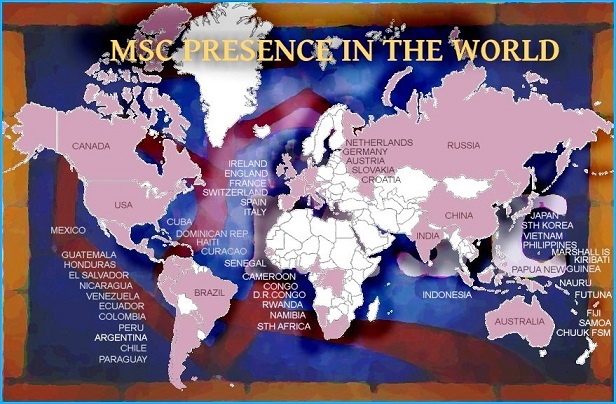
LAY MSC NEWSLETTER AUGUST 2017.

Contents
From the Director
Third International Conference of the Laity of the Chevalier Family
Chevalier and the Organization of the Lay Branch of the Chevalier Family
FROM THE DIRECTOR
An international meeting of the Lay MSC was held in Sao Paulo in Brazil in July. At that meeting Alison McKenzie from Australia was elected as the first General Secretary of the Laity of the Chevalier Family. The group includes not only those who share the charism of the MSC, but also of the OLSH Sisters and the MSC Sisters. Our warm congratulations to Alison.
This newsletter will include only a copy of the paper given by Hans Kwakman at the meeting and a summary of the meeting by Fred Stubenrauch who was the other Australian representative at the meeting.
May God’s blessings be with all of you.
Jim Littleton MSC
Third International Conference of the Laity of the Chevalier Family |
|||
By Fred Stubenrauch
“Spirituality without Borders: Vision and Mission of the Laity of the Chevalier Family” |
Countries represented included Australia, Brazil, Republic of Congo, Senegal, El Salvador, Guatemala, Mexico, Dominican Republic, United States, Paraguay, Peru, Ecuador, Korea, Philippines, France, Belgium, Germany, Netherlands.
The Tri-Generalate was represented by Sr Merle Salazar (OLSH), Fr Wahyudi (MSC) and Sr Bonaventura (MSC Sisters)
Each day began with a reflection presented by a different country and each day ended with the celebration of Eucharist again by a different country.
Speakers presented talks on several topics and a lot of time was spent discussing the “Guidelines” document and voting for nominees for the position of General Secretary.
NOTE: The “Guidelines” document is titled “General Guiding Principles and Statutes of the Laity of the Chevalier Family”. This document was approved by the assembly of those present and will be published widely in the near future.
The General Secretary of the Laity of the Chevalier Family together with the International Council will have responsibility for overseeing the development and organisation of the Laity of the Chevalier family. Alison McKenzie was elected to this position and together with her deputy, Doris Machado (Brazil) will begin the process of selecting an International Council early next year.
Travelling to Brazil was quite an event as our flight from Australia scheduled for Sunday 16th July was cancelled. I was lucky enough to be accommodated overnight in Sydney but our OLSH and PNG friends not so. They spent some 36 hours on planes and in airports.
Tuesday 18th
Rita Cleuren gave an overview of the development and growth of Laity of the Chevalier Family over the past 20 years, from the first International Gathering in Issoudun in 1999 to Santo Domingo in 2008 and Brazil in 2017. Much of this development has been guided by Rita and other members of the European Committee.
Most of the remainder of the day was spent in getting to know other people present and in exploration of the theme of the conference.
Wednesday 19th
The topic for the first session was “In What Way was Jesus a Border Crosser?”.
This was presented by Sr. Merle Salazar an OLSH sister from Philippines who is now attached the Generalate in Rome.
Jesus crossed, ignored, went around, and used borders. He left some intact, some changed, some destroyed and made some new ones.
She reminded us of a story Nick Harnan MSC told at the meeting in Santo Domingo : (something like this)
After he died Jesus called people from all countries together. “How will what I have commenced be continued?” A person who was a good preacher said, “I will do that”. So the Dominicans were begun. Another said “ I care about the creatures of the Earth and about the very poor so I will look after that aspect”. So the Franciscans were born. After many spoke up about continuing some aspect of Jesus’ nature he said, “And who will spread my love as answer to the ills of society?” A quiet parish priest from Issoudun said, “I will do that”. So Spirituality of the Heart was continued.
In the afternoon session, Sr. Mercy Mejia Benitez MSC from Guatemala, presented a talk “ Jesus’ Image of God and His Spirituality”.
Images of God can be counterproductive to our understanding of God sometimes in conflict with our images of Jesus. She used texts from New Testament to describe Jesus. Images of light to the world, good shepherd, resurrection and life, way of life, the true vine, meek and humble of heart.
Thursday 20th
The Brazilian Laity led us on a pilgrimage to the basilica at Aparaceibo about 2 hours bus trip away. It was the 300th anniversary of the discovery by a fisherman of a headless statue of Mary in the river. In the time since many miracles have been attributed to the statue. Originally a small chapel was built and it has over the years grown into a massive structure – very imposing with decorative tiling and many impressive statues. There is a TV studio, a huge canteen, many eating areas, candle shop, a gift shop, parking for hundreds of buses and cars plus a whole shopping centre with massive food hall and kiosks that sell all sorts of things!!! I was even able to buy a phone charger there! Mass was a spectacular affair with a MSC bishop and 30 MSC priests presiding. Music was good with enthusiastic singing and announcements similar in volume to those at a rock concert. There were literally thousands in attendance and this was supposed to be a quiet day!
Friday 21st
This is to be our (Australia) day!
We started with very moving liturgy prepared by Alison during which the video of Anne Gardner OLSH receiving her recognition as Senior Australian of the Year was shown. The topic of my presentation was “Fr. Chevalier’s Vision: A Mission Without Borders”. It seemed to go well with some positive comments after and a few wanting a copy!
Alison’s followed with a presentation on the above theme from Australian context and it was very well received. After her talk Alison provided two questions that generated much discussion especially about how to involve young people in the lay MSC movement.
NOTE: We will provide our presentations by separate email to any who would like them – just send me an email request.
There followed a presentation by Hans Kwakman MSC “ A New Concept for Organisation of the Lay Family; The Role of Laity in the Chevalier Family”
Note: This paper is included in this edition of Lay News
Saturday 22nd
We were divided into language groups and encouraged to reflect on the topic
“The Future and Vision of the Laity of the Chevalier Family”.
Later in the day we voted for the acceptance of the “Guidelines”. They were accepted unanimously. One person from each country plus four members of the International Committee were allocated voting rights. There followed several reports of formation in some (selected) countries. I will write more about this for a later edition.
Sunday 23rd
We were taken on a pilgrimage that began on a bus at 7:00 am to Mass at Notre Dame du Sacre Coeur – about 1 hour drive. This was a huge event. As we arrived the first Mass was coming out – more than 1000 people. Once again it was an ‘event’ with great music and singing. All the Ministers of the Eucharistic wore a grey uniform and looked very official. After Mass we were fed downstairs and then travelled to the OLSH Provincial House – very neat with vegetable gardens and many quiet places in the grounds. The sisters run a school there for disadvantaged people teaching English and practical skills. More food and entertainment followed!
Next we travelled by small bus to the parish of San Miguel. The MSC had asked the bishop for a parish in a poor area, in the slums (not a favelo we were quickly reminded). Very poor housing and crowded. Our guide explained that people are attracted to Sao Paulo as a ‘dream’ place to be and when they get there find that things are not as they imagined. We visited three churches and each one provided some sort of ‘school’ and food bank. At the last one we were fed (again) and entertained by a band and dancers – a bit like square dancing. The parish priest later told us that the people were grateful for our visit as most people try to avoid them.
Monday 24th
Election of the General Secretary: Each nominee was announced and spoke. Nominees – Doris Marchado (Brazil); Lynn Ditlow (USA); Silvi Barghon (France); Maribel Lopez (Guatamala); Hipolito Rosario (Dominican Republic); Ingrid Manzano (El Salvador); Alison McKenzie (Australia)
Election: There were 23 eligible to vote (1 each country and 4 International committee). Majority was to be 50% plus 1 i.e. 13. After two rounds of voting Alison was declared elected with Doris as deputy.
Tuesday 25th
Sr Marisa Aquino, OLSH from Brazil gave a lecture connecting “Pope Francis and Spirituality of the Heart”. She drew many comparisons between Jules Chevalier’s charism and that of Pope Francis and made the point that Jules and Francis are separated by time but connected in Spirituality.
Evaluations followed and our then final liturgy. It was very moving as you can imagine. We began the conference as strangers but ended as friends and confreres. I returned to Australia
enthused about the future of the Laity of the Chevalier Family. There are many things to consider and much to do over the next years.
The next General Assembly of Laity will be in six years in a country to be decided. Guatemala has offered but I fancy Korea but will probably be too old to go by then. A wonderful enriching experience that strengthened my feeling that we are part of a thriving worldwide movement of great promise!!
Chevalier and the Organization of the Lay Branch of the Chevalier Family
by Hans Kwakman MSC, Sao Paolo, July 2017
The Chevalier Family will only have a future if it remains faithful to its identity as shaped by the charism of Fr. Chevalier. By saying so, I just repeat what, more than a century ago, has been said in other words by Fr. Piperon MSC: “If a religious family does not wish to perish, it must lovingly preserve the spirit it has received from the Founder.” What Fr. Piperon called “the spirit of the Founder,” today we would call “the charism of the Founder”. The charism or spirit of our Founder included the foundation of the Chevalier Family as a spiritual union of religious fathers and brothers, secular priests and groups of laity or individual lay persons as well.
In the first part of the following presentation, I’ll try to indicate Fr. Chevalier’s original intentions in erecting his Society of the Sacred Heart as being open for religious, secular priests and laity. Following generations misunderstood Chevalier’s intentions, but the renewed MSC Constitutions of 1985 restored Chevalier’s initial project. In a second part I’ll show that, just as in Chevalier’s time, today as well, the Chevalier Family needs a clear structure that will support the mutual responsibility of the three branches for each other, with special attention to the Lay Branch of the Chevalier Family.
The Chevalier Family will only have a future if it remains faithful to its identity as shaped by the charism of Fr. Chevalier. By saying so, I just repeat what, more than a century ago, has been said in other words by Fr. Piperon MSC: “If a religious family does not wish to perish, it must lovingly preserve the spirit it has received from the Founder.” What Fr. Piperon called “the spirit of the Founder,” today we would call “the charism of the Founder”. The charism or spirit of our Founder included the foundation of the Chevalier Family as a spiritual union of religious fathers and brothers, secular priests and groups of laity or individual lay persons as well.
In the first part of the following presentation, I’ll try to indicate Fr. Chevalier’s original intentions in erecting his Society of the Sacred Heart as being open for religious, secular priests and laity. Following generations misunderstood Chevalier’s intentions, but the renewed MSC Constitutions of 1985 restored Chevalier’s initial project. In a second part I’ll show that, just as in Chevalier’s time, today as well, the Chevalier Family needs a clear structure that will support the mutual responsibility of the three branches for each other, with special attention to the Lay Branch of the Chevalier Family.
Part I: Chevalier’s original intentions in erecting a Lay Branch of the Society of the Sacred Heart
Someone, who clearly understood the originality of Fr. Chevalier’s charism, was the Jesuit Fr. Ramière, a friend of Fr. Chevalier and a sincere supporter of his works. He was the director of the “Apostolate of Prayer” in France and Editor in Chief of the French edition of the “Messenger of the Sacred Heart”. In 1869, Fr. Chevalier needed the approval of the Archbishop of Bourges and the Vatican for his first draft of the MSC Constitutions. In these Constitutions, Chevalier did not only describe the spirituality and rules of the MSC Congregation, but also included a place for the Association of Secular Priests and the so-called Third Order of lay people.
In a letter to a lay-member of this Third Order, Fr. Ramière wrote: “In case the Vatican is not prepared to include secular priests or laity in these Constitutions, then the MSC Congregation will in no way differ from “one hundred and one” already existing Congregations.” Fr. Ramière understood that Fr. Chevalier was searching for something that in those days was new. Chevalier wanted to establish a Society in which people of different ways of life would come together, being inspired by the same charism and mission, either as religious men and women or secular priests or lay people. Chevalier really wanted to cross the boundaries of what was normally practiced in the Church of his day.
While remaining in their parishes and dioceses, the Secular Priests of the Sacred Heart would carry out the same mission as the Religious of the Sacred Heart. The lay people, united in a Third Order, would perform that mission, while staying in secular society and continuing to perform their daily occupations. By officially approving Fr. Chevalier’s design of the Constitutions, both the Archbishop of Bourges and the Vatican accepted his wide-ranging plan for this new kind of Society.
From an earlier correspondence with some Jesuits in Paris, it became clear that Chevalier was searching for a structure which should function as an umbrella for people living either in or outside religious communities, with or without vows, while the religious Missionaries of the Sacred Heart, would form the core group of this big Society. The Jesuits offered a general plan for such a society, but recommended Fr. Chevalier, as the founder, to draft a more detailed plan himself.
So, in 1864, Fr. Chevalier came up with his own “Plan of the Society of the Missionaries of the Sacred Heart,” in which he pointed out a basic principle of his vision: “In order to fulfill its mission the Society must spread as much as possible, but it will spread only so far as it answers the various aspirations of the people.” Chevalier wrote several documents in order to explain this vision in detail.
Each document opened with a description of the ills of the time. This fact clearly shows
Chevalier’s conviction that each of these three “branches” should participate in the same mission, in such a way that their presence and activities would be relevant to the renewal of society. In a comment on this, Fr. Murphy notes: “Reading his early publications, about the nature and mission of his Society, I have the strong impression that (Fr. Chevalier) would have found it unthinkable, or perhaps even impractical, to speak of changing the world and its values without involving laity, for they were the ones more intimately immersed in that world. Religious priests, brothers, sisters, together with secular priests, had an essential role to play, and Father Chevalier stressed that. But if Christ’s mission was to be continued in the world on all levels of society, the role of the laity was at least equally as essential and at times even more essential.”
Chevalier emphasizes that the members of the Third Order should remain in their families, while continuing to occupy their regular positions in secular society. If those who were single would like to form communities, they should avoid "anything that gives the appearance of a religious house …, as being against our aim and harmful to the sort of good that this work is called to do.”
In March 1869, the Vatican granted the MSC Congregation a “Decree of Praise”, and by doing so, officially acknowledged the Missionaries of the Sacred Heart as a pontifical, religious congregation, with “the Association of Priests of the Sacred Heart” and “the Third Order of the Sacred Heart” as integral parts. In the first MSC Constitutions of 1877 the Association of the Laity is included in the chapter, entitled “The Aim of the Society of the Missionaries of the Sacred Heart”. That means, as Fr. Murphy notes that Fr. Chevalier, “wanted to incorporate laity into the specific life and mission of the Society.”
During the rest of his life, Fr. Chevalier attempted to carry out this broad vision with unflagging energy. In January 1878, he could write: “Today, (the Third Order) numbers about three hundred members spread through ... France, and also in Italy, in Belgium, England, Austria and Canada: every day new people join up.” However, Chevalier had to admit that his own confreres did not always understand the importance of the Third-Order. In a letter of 1900 to the Superior of the Province of the North, who complained about a certain confrere who did not support the Third Order in the Netherlands, Chevalier expressed his amazement by writing: “I wish that in our provinces and in our houses, everyone supports the Third-Order of the Sacred Heart... It would be more than strange that Missionaries of the Sacred Heart refused their collaboration and dedication to our works of the Sacred Heart.”
In spite of difficulties in finding confreres, who were willing to become “directors” of the groups of lay-associates, Fr. Lanctin MSC, the new General Superior, in a letter to the Vatican of 1904, could report that at the time the Third Order of the Sacred Heart numbered “nearly two thousand members spread throughout most of the Catholic countries of Europe”.
However, in 1907, a far-reaching change happened. An extraordinary General Chapter - not attended by Fr. Chevalier, due to reasons of health - introduced a comprehensive revision of Chevalier’s Constitutions, in use since 1877. In two ways this revised version of the MSC Constitutions deviated from Fr. Chevalier’s original Charism and intentions. First, no longer was the Devotion to the Sacred Heart presented as a remedy for the ills of the times; and second, no place was given to the accompaniment of secular priests and lay people, who wanted to share in the charism and mission of the religious members of the Chevalier Family. Due to these radical changes, the laity were no longer seen as fellow members participating in the same mission and practicing the same Spirituality. Fr. Ramière’s fears had come true: the MSC became a congregation that in no way differed from so many other existing congregations that carried the title “Sacred Heart” in their name.
Finally, after the Second Vatican Council, the MSC Constitutions returned to the original inspiration of our Founder: “Our Founder wanted the fullness of mission to be realized in a global project with religious men and women, diocesan priests and lay people. He especially wished to have an association of lay people closely united with the professed members in their spirituality and mission (Constitutions of 1877). For this reason the Provincial Superior will promote this Association of Lay MSC. He will also encourage the members of the Province to collaborate in this work. He will appoint a coordinator to help in the development of this Association in relation to us, while respecting its lay character.”
In 2009, the three General Administrations of MSC men and women and the Daughters of Our Lady of the Sacred Heart together with the Coordinator of the Laity of the Chevalier Family, issued a “Joint Communiqué” in which formation is indicated as a top priority of the whole Chevalier Family. In this document “the religious are encouraged to continue to devote time and energy to the formation of the laity.” In the same Communiqué the hope is expressed “that more and more laity themselves will become formators for lay members of the Chevalier Family.” Totally in line with Fr. Chevalier’s intentions, the “Joint Communiqué” emphasizes that what is especially needed is “formation in our common spirituality,” a Spirituality of the Heart.
Part II: The Organization of the Lay Branch of the Chevalier Family
In a document of 1865 concerning the Lay Branch, Fr. Chevalier stated that everyone,
married or not, who, in accordance with her or his social status within the world, wants to grow in love, is welcome as member of the Association, also called the ‘Third Order’. Members of the Third Order will attend an initial program of formation in a Spirituality of the Heart, and observe some basic rules. However, they should remain in secular society, with or without vows or promises, either as a single person, family member or in community.
Regarding the organization of the Third Order, Fr. Chevalier speaks of Directors and Superiors. The General Superior of the Missionaries of the Sacred Heart or his delegate is the General Director. There might be also a need for diocesan and local Directors. The directors have only an advisory function and are chosen from among the religious or secular Priests of the Sacred Heart. The administration of the Third Order consists of a General Superior as well as diocesan and local Superiors, each with their own councils, all chosen from among the lay-members.
In relation to Fr. Chevalier’s view of the organization of the Third Order, we should take into consideration that he wrote this document regarding the Third Order in 1865, at a time when the Congregations of the Daughters of Our Lady of the Sacred Heart and the MSC Sisters did not yet exist, and the MSC Congregation had not yet been divided in provinces. For us it is important to notice that, in spite of many difficulties, Fr. Chevalier made continuous efforts to get the Third Order off the ground. MSC would be responsible for the well-being of the Lay Branch by accompanying it on all levels; and the Lay Branch itself would be structured with a strong organization, supported by the laity itself.
Taking into consideration the developments of the Lay Branch in our day, it is appropriate that the role envisioned by Chevalier in the past and entrusted to the MSC, will now be played by the three Chevalier Congregations. That means that they will assign Spiritual Directors or Advisors, while the three General Administrations together will function as General Director. The laity itself will provide for the administration of the Lay Branch of the Chevalier Family.
Today the Lay Branch of the Chevalier Family is spread all over the world where MSC men and women as well as Daughters of Our Lady of the Sacred Heart are present. Groups of lay people of all cultures, orientations and compositions feel themselves a part of the Chevalier Family. Some are more closely connected to MSC fathers and brothers, others to the Daughters, others again to the MSC Sisters. Some groups are more devotional in their orientation, others are more socially oriented, others again put emphasis on reflection, meditation or deepening of faith, while for all the groups socializing is an important element of their gatherings as well. In any case, they all want to follow the way of the heart as shown by Jesus Christ who loves with a human heart.
Fr. Chevalier’s basic principle is clearly in the process of being carried out. After all, he wrote: “In order to fulfill its mission the Society must spread as much as possible, but it will spread only so far as it answers the various aspirations of the people.” We are pleased to see that at present the Chevalier Family is able to offer an answer to “the various aspirations of the people.” Or, to paraphrase a saying of Jesus in St. John’s Gospel: not only in the Father’s house, but also in the house of the Chevalier Family, there are “many rooms” (John 14: 2) available.
So, by proposing a well-constructed organization for the Lay Branch of the Chevalier Family, it is not our intention to create boundaries or to restrict the variety of activities of the groups. The only intention is to give the “many rooms” of the Chevalier Family a solid roof, supported not only by our lay brothers and sisters themselves, but also by the religious members of the Chevalier Family: the MSC men and women and the Daughters.
Therefore, a central element in the proposed organization of the Lay Branch of the Chevalier Family is the National Board (which may go by any other name). This Board consists of a representative of each Local Group in the country, along with the Provincial Superiors (or representatives) of the Congregations of the Chevalier Family, present in a certain country. Until now such a body only exists in a few countries. Some lay-groups are still dependent on the commitment of some religious and run the risk of disappearing, when the involvement of these persons comes to an end. In other countries, there does not yet exist a well-organized collaboration between the Chevalier Congregations in relation to the accompaniment of the local lay-groups.
The main responsibility of a National Board would be to support a continuous presence of lay-groups in the country and guarantee the on-going formation regarding a Spirituality of the Heart of its members as well, “while respecting its lay character.” A National Board will also be the body qualified to send official representatives of the lay groups of a certain country to the General Assembly, with the right to vote and to take part in elections. The establishment of a National Board needs the support and collaboration of the Provincial Administrations in each country.
Already the General Assembly came together twice before, namely in Issoudun and the Dominican Republic. This year (2017) it meets again in Sao Paulo. The intention is that the General Assembly will become a body which officially represents the Lay Branch of the Chevalier Family, with the right to take binding decisions. Therefore, at least a part of the participants should be formally appointed, either by election or nomination, as official representatives of the laity of a certain country.
At present the International Board or Executive Board only consists of representatives of European lay groups and meets twice a year. It is normally accompanied by
representatives of the Tri-Generalate and a Spiritual Advisor. The proposal is to make it into an intercontinental, executive body of the General Assembly. To that end, at least some of its members should be elected by the General Assembly, e.g. the General Secretary and the first assistant. They should be given the right to invite some other people to become members of this Executive Board, preferably from different continents, in order to guarantee the intercontinental character of the Lay Branch of the Chevalier Family. We imagine that, due to the distances, communication among the members of the International Board will mainly be carried out by communication media, such as email, Skype and WhatsApp.
Finally, regarding our Spirituality and Mission, we purposely propose Guidelines, which are very basic. Every family of national lay-groups or even a local group might feel free, if they want to do so, to formulate their own Guidelines in agreement with their own cultural customs, as long as they remain faithful to the basic orientation of these general Guidelines. In fact, our common Spirituality and Mission, inspired by Fr. Chevalier’s charism, is what brings us together, all over the world.
Hans Kwakman, MSC 2017

